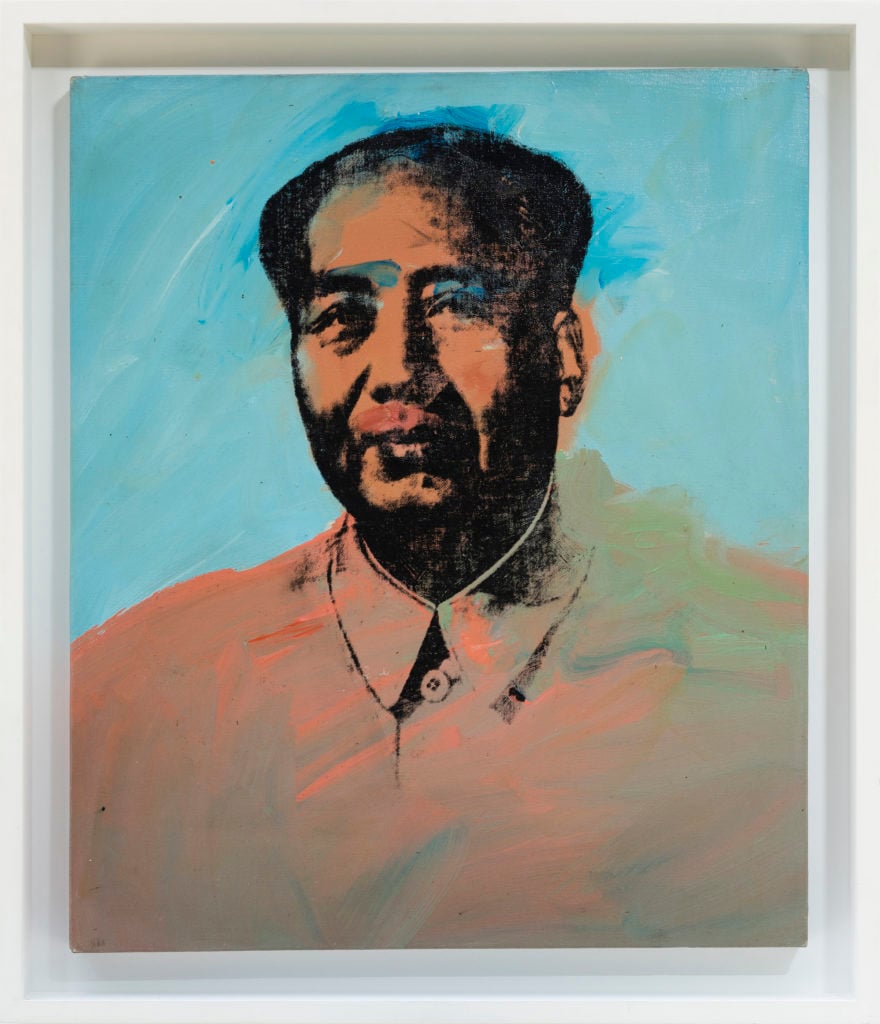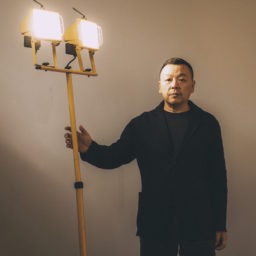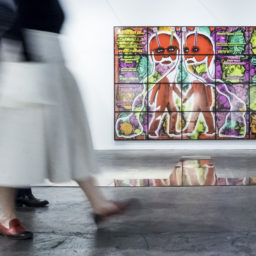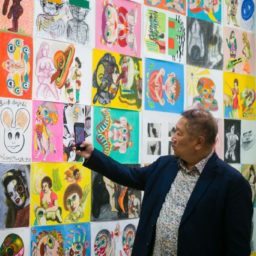If your twinned criteria for a successful art fair are the quality of the work on offer and the novelty of its content, there may be no better fair in the world these days than Art Basel Hong Kong. Here are some of the most notable pieces to be encountered in this buzzing sixth edition of the event, taking place at the exact moment when the long-separated components of the Eastern and Western art markets have finally emulsified.
Yu Hong
A New Century (2017)
Long March Space – Beijing
In the $800,000 range
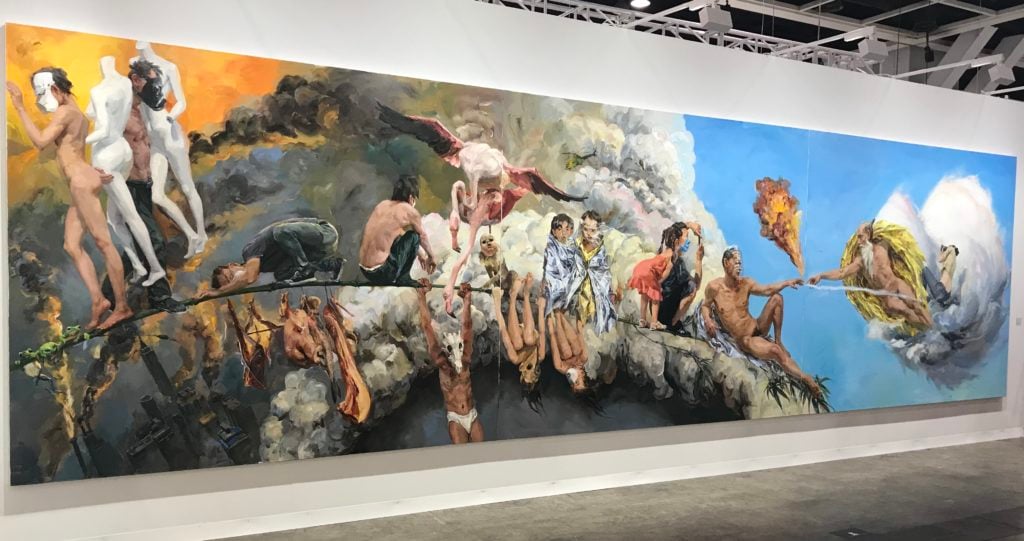
Photo by Andrew Goldstein.
A staggering wall-swallower by the sensationally talented painter Yu Hong, the canvas that steals the show in the artist’s solo booth for Long March Space is a 18-foot triptych showing a nightmarish scene. At the far left corner, a city (recognizably New York) burns, sending a noxious cloud of smoke into the sky, where a motley crew of refugees cling to a long bamboo pole, some swaddled in reflective emergency blankets, some cavorting with naked mannequins, others wearing animal skulls and dangling from the pole alongside drying meats; a monkey in a baby mask stares at two flamingos flying past, while a trio of frogs cluster underfoot; at the right, a man wearing a plastic water bottle as a mask recreates the pose from Michelangelo’s Creation of Adam while an Asian deity manifests from a sonic-boom cloud to touch his hand, the synapse of their fingers emitting an explosion.
Like much of her work, the painting is a commentary on the ills the artist sees in the mental and environmental state of the modern world, and it is as depressing as it is ravishing, impressively painted in the cool jewel-like tones of Tiepolo. Not even the largest painting Yu has made—she excels in cinematic scale, a trait she shares with her husband, the similarly extraordinary painter Liu Xiaodong—this masterwork will be exhibited in the artist’s retrospective at Shanghai’s Long Museum next year. Work like this makes the medium of painting feel arrestingly alive, but Yu is hardly standing still: around the corner from the canvas, you can put on a headset and watch the artist’s latest VR work, also beautiful.
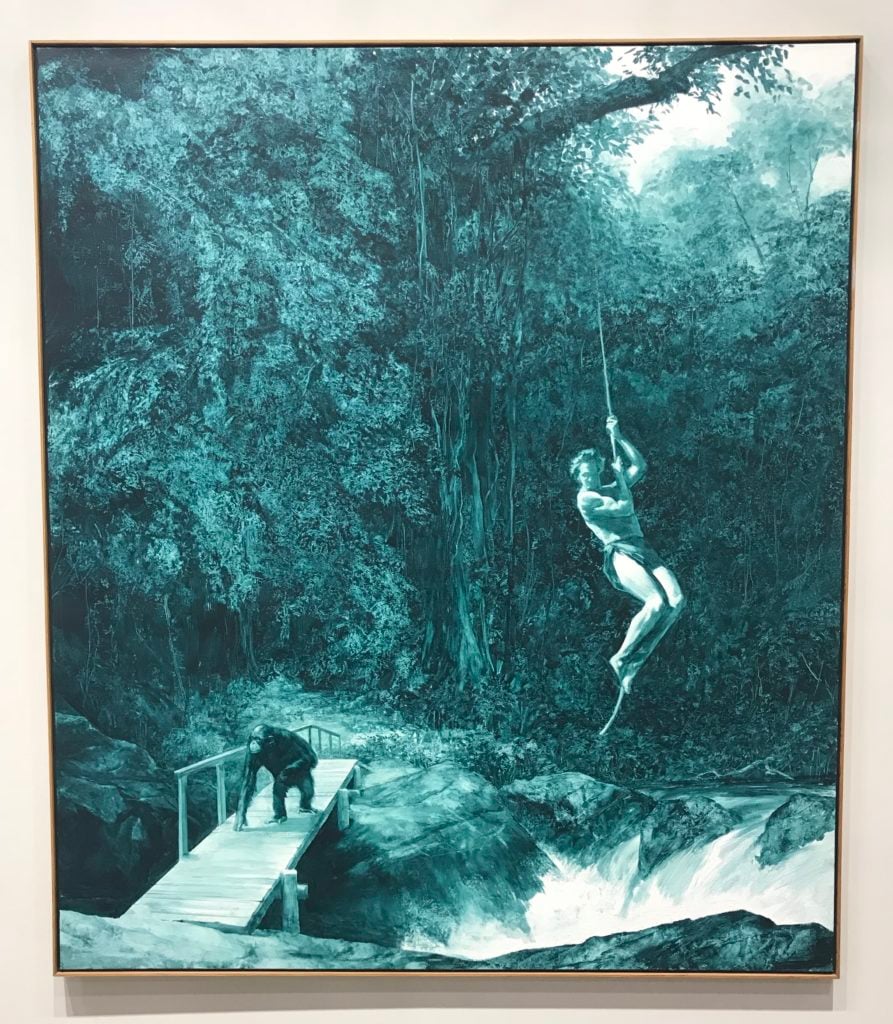
Photo by Andrew Goldstein.
Mark Tansey
Nature’s Ape (1984)
Lévy Gorvy – New York
$4.2 million
A longtime participant in the Chinese art market whose gallery recently expanded with a new Shanghai office, Brett Gorvy plots what he brought to Art Basel Hong Kong logically, methodically, and—given the sale of Paul Allen’s de Kooning for $35 million on opening day—very effectively. This Mark Tansey is a useful example of Gorvy’s winning three-part strategy for catering to Asian collectors:
1. Display Exceptional Technical Skill
Executed in a monochrome green wash, this vibrantly detailed near-photorealistic painting is clearly made by a master of the medium, with Tansey using Tarzan and the ape to relate one of his signature allegories of art history. (Tarzan, the more highly evolved human, swings extravagantly across a stream, while the ape, the more old-fashioned, traditionalist creature, sagely and simply walks across the bridge, kind of like how painting is better than flashy “cutting-edge” art forms.) “A lot of collectors here like to see technical virtuosity and a singular style,” Gorvy explained.
2. Be Rare
Tansey only makes about one painting per year, meaning that there are relatively few on the market, and this piece hasn’t been offered for sale since it was painted in 1984.
3. Have Comps
To assure collectors that the work is well priced, Gorvy likes to be able to reference comparable sales results for an artist he’s introducing to the region. Tansey, for instance, has a record of $5.8 million at auction, and five of his paintings have sold over the $4.2 million asking price over the past decade, according to the artnet Price Database.
Midway through the first day of the fair, a collector had already asked to put the work on hold.
Zhang Xu Zhan
Si So Mi Hsin Hsin Joss Paper Store – Room 004 (2017)
Project Fulfill Art Space – Taipei, Taiwan
$8,600
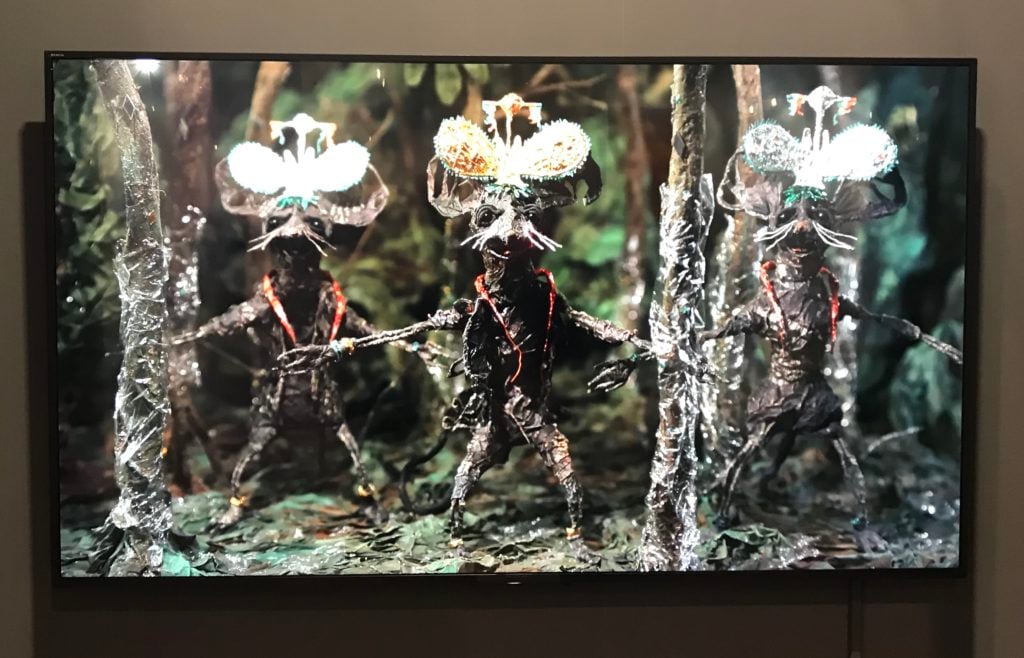
Photo by Andrew Goldstein.
A scion of the Taiwanese family that owns the famous Hsin Hsin Joss Paper Store, a century-old boutique that makes elaborate paper effigies to be burned in funerals, the Zhang Xu Zhan had his own first encounter with death as a child as he watched his parents trap a rat in a cage and then submerge it in a bucket of water. At the time, the young artist was delighted to see the rat futilely clawing at the water as it drowned—it looked like it was dancing.
Today, Zhan carries on his family heritage by creating beautiful paper sculptures that he uses to shoot stop-motion videos that meditate on death not as a sad occasion but as a joyous transition to a new state of being, like this hard-to-shake marvel at the fair: imagining a festive birthday party in the forest, the video revives the dancing rat from the artist’s childhood as a chorus line of dancers who rhythmically claw the air as a band plays and as a ghostly water level seems to rise in the air around them; in the middle of the celebration, a young rat appears to materialize under a conical party hat.
Stranger still is the music that the rats play, pouring out from the video into the aisles of the fair. A sweetly sad-sounding melody, it’s a romantic German folk song that was one of the few pieces of European music in circulation when Western-style musical instruments were introduced in Taiwan in the 1920s, and which has since been embraced as a common song played at Taiwanese funerals—a deathly version of “Happy Birthday.” The transmogrification of meaning inspires the artist.
A 30-year-old rising star who is currently the artist in residence at Hong Kong’s Rooftop Institute, Zhan will show this video alongside its paper models at the National Museum of Modern and Contemporary Art in Seoul in an upcoming show. The fourth in a planned series of 10 videos dedicated to his family’s store, it was made in an edition of five (plus two artist’s proofs), with the one at the fair being the last available for sale.
Alice Neel
Robyn Evans (1968)
Xavier Hufkens – Brussels
Just under $1 million
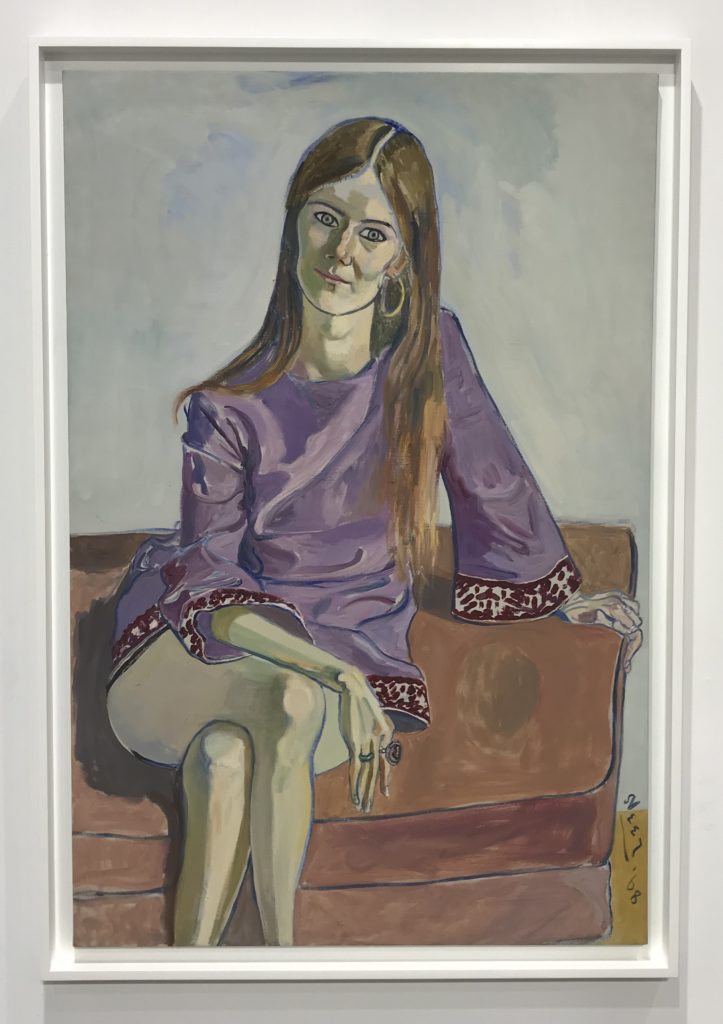
Photo by Andrew Goldstein.
At a moment when Western art has found an unprecedentedly receptive Asian audience, one imagines that dealers put a great deal of effort into thinking through the kind of work they bring to a fair like Art Basel Hong Kong. Do you select a grand work of art-historical heft with an aim to impress, or bring something on the cutting edge to expand horizons and cultivate taste?
Asked why he decided to bring this 1968 Alice Neel portrait of Robyn Evans, Xavier Hufkens had a thoughtful response. “I visited quite a lot of studios in China, and there was some unconscious thing that connected this picture to a number of artists in Asia,” he said, noting that it had several elements he expected might appeal to an Asian buyer. The red pattern around the sleeves and hem looks classically Chinese, for instance; even the artist’s signature, scrawled sideways at the lower right, looks a bit Chinese at a quick glance, he said.
These sympathetic details may have been enough to convince the Chinese collector who snapped up the painting at the fair, paying just under $1 million, according to the gallery. Of course, context is everything when it comes to art, as are the stories woven in the mind of the beholder. One suspects that the portrait’s mysterious, ineffable Chinese-ness may have been less evident when the gallery showed the same Neel painting a few short months ago at Art Basel in Miami Beach.
Handiwirman Saputra
Hari Ini Kemaren Esok (Seri Tak Berakar Tak Berpucuk) (2018)
Nadi Gallery – Puri Indah, Jakarta
$350,000
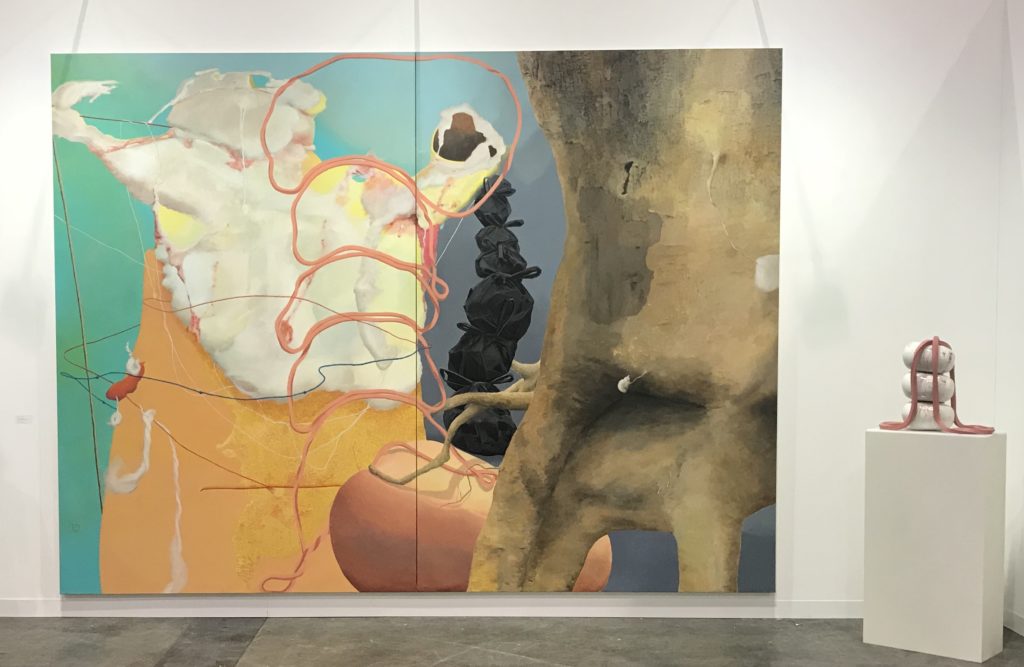
Photo by Andrew Goldstein.
Based in Yogyakarta, the 42-year-old Sumatran artist Handiwirman Saputra is one of the founders of the Jendela Art Group, an Indonesian art collective that was built upon the pragmatic understanding that it would be easier for a group of local artists to attain success than for the individual artists on their own. (It worked—the group has become renowned in their region.) The most famous of the collective, Saputra was trained as a sculptor and often incorporates rubber bands, garbage bags, and other pieces of found rubbish into his work—a magpie aesthetic that he also carries over into his impressive paintings, which translate his trash inspirations into convincingly rendered volumetric forms that populate colorfully abstract voids.
The artist’s renown has been spreading beyond Indonesia in recent years—he had a solo show in 2015 at Tokyo’s Mori Art Museum, which bought two paintings, and has collectors in France and Germany—and now his gallery has brought Saputra’s work to the fair in the hopes to further establishing his reputation more widely. “We are showing it to everybody,” said Biantoro Santoso, the founder of Nadi Gallery.
Philipp Timischl
It’s So Inspiring How Hard She Works to Put Her Dogs Through College. Calmly Killing It. (2018)
Galerie Emanuel Layr – Vienna, Rome
$7,800
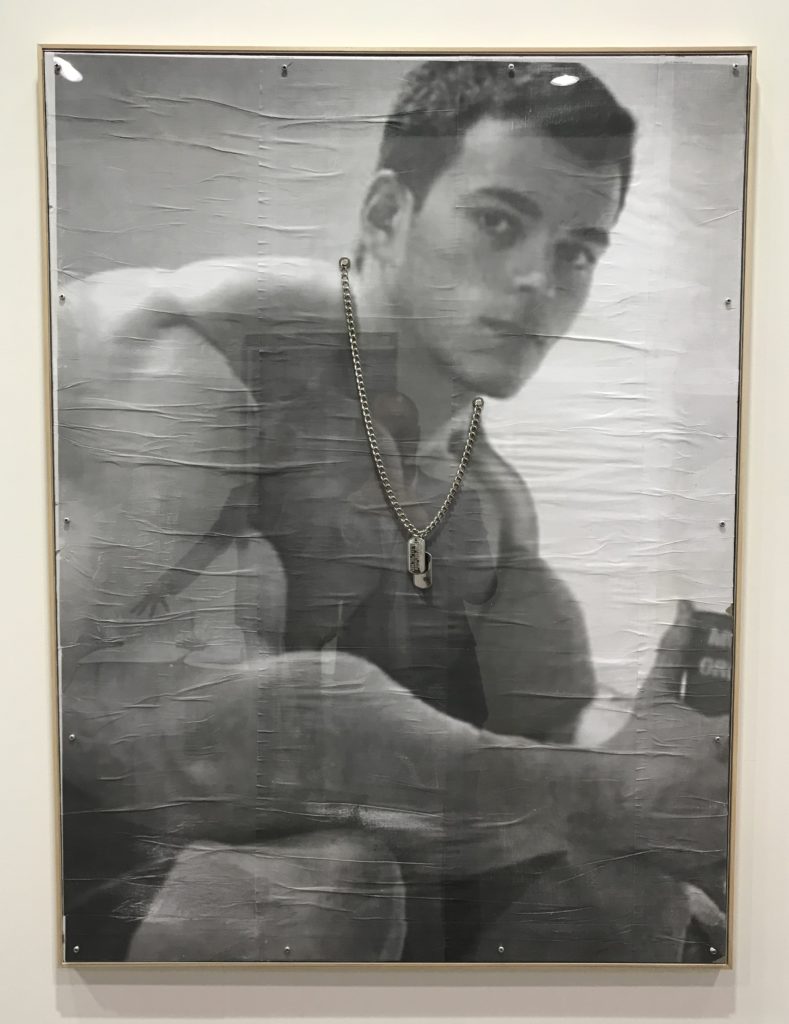
Photo by Andrew Goldstein.
The young Austrian artist Philipp Timischl (born 1989) is interested in how images accrue new meanings as they circulate online, and for this series he focused on a particular phenomenon he observed: young heterosexual men would photoshop their heads onto the bodies of far brawnier bodybuilders to create hypermasculine idealized self-portraits, and then these images would be reappropriated on gay Tumblr blogs. Printed out at large scale at the fair and paired with dog tags that read private texts gathered from social media—and displayed behind life-size photos of the artist in drag—the works stand out as being highly unusual at the fair, where most dealers keep any reference to sexuality to a minimum to their booths, and non-heteronormative art is particularly scarce.
“The reaction so far is very strange,” according to the dealer Emanuel Layr. “People have been irritated. Some people are intimidated.” Layr said that questions about gender or sexuality are secondary to the artist, whose primary concern is the malleability of identity online, but acknowledged that that particularly Chinese society remains “macho and male-dominated”—although “the younger generation is very different in the South and Hong Kong.” For the dealer, the art was more important than any squeamishness on the part of the audience. “I thought the project was so convincing I just felt I had to show it,” he said, “I didn’t care if it was China, America, anywhere.”
Frog King Kwok
Frog King Kwok Calligraphy Shop (1992)
10 Chancery Lane – Hong Kong
$100 to $12,000

Photo by Andrew Goldstein.
The artist Kwok Mang-Ho trained as an ink painter and calligrapher but, after working as the set designer for Hong Kong’s Experimental Cantonese Opera association, wholly reinvented himself as the endearingly zany performance-art legend Frog King Kwok. Dressing in outlandish outfits and wearing bug-eyed glasses and enormous hats, every inch the shaman of his own amphibian religion, the Frog King moved to New York City in the beginning of the 1980s and became known for his overwhelmingly maximalist installations of hundreds of drawings, posters, photographs, and other peppy objects that he used to fill gallery spaces, storefronts, whatever he could get his hands on.
At the fair, the artist recreated an installation that he created at the New Museum in 1992, with several framed historic drawings on the wall for sale between $5,000 and $12,000. However, the best deal at the fair could be found courtesy of the Frog King himself, who held court in the middle of his chaotic welter, offering to render any name or phrase you request in Chinese calligraphy for about $100. Now 70 years old and back in Hong Kong since 1995, the affable king was attended at the fair by a smiling young acolyte, decked out in the trappings of Frogtopia.
Ashley Bickerton
The Bar (2018)
Gajah – Singapore, Yogyakarta
$290,000
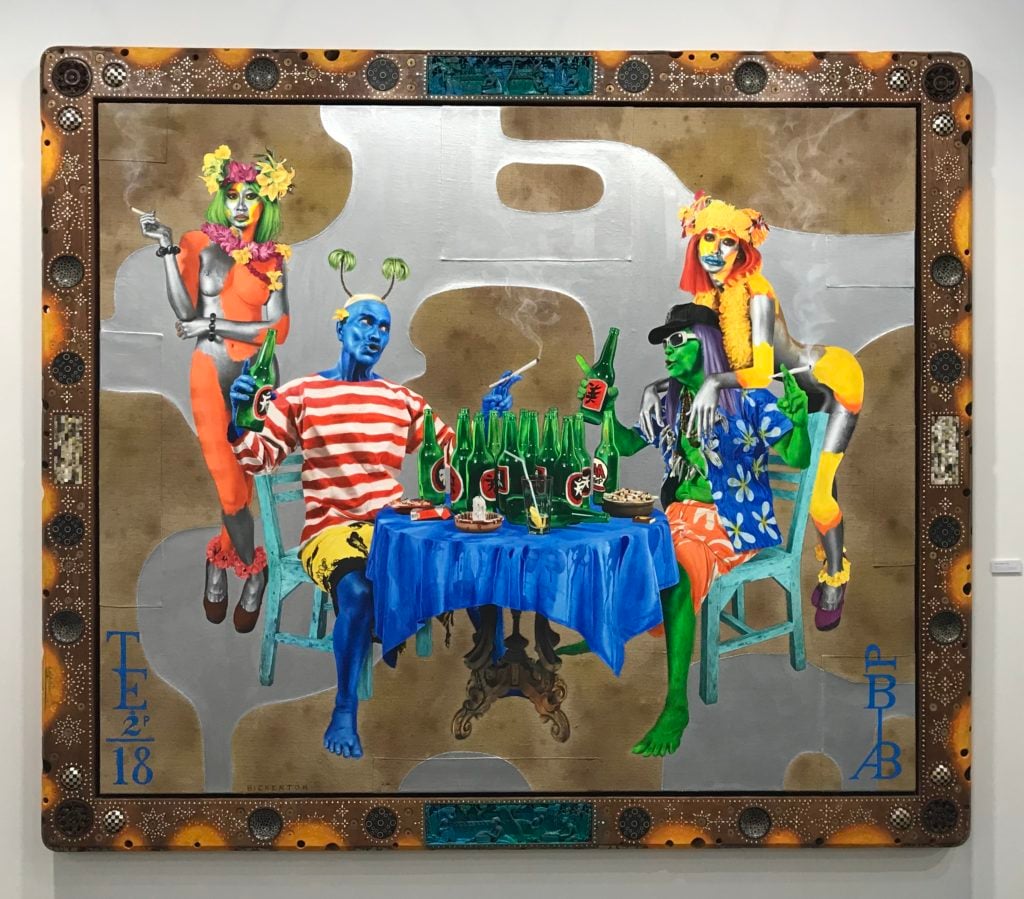
Photo by Andrew Goldstein.
One of the few famous Western artists to have spent a long time in Asia, Ashley Bickerton has lived on the tropical island of Bali for the past 23 years, creating paintings and other artworks that exploit kitsch and clichés about cultural exchange to deliriously toxic effect. This painting, for instance, satirizes the trope of the “washed-up caucasian,” according to the artist’s dealer Jasdeep Sandhu, showing a pair of decadent middle-aged wastrels arguing over a beer-strewn table as their bored girlfriends mill around naked—a commentary on “sexism,” the dealer says. The key point of interest for Bickerton, though, may be his extraordinary application of materials and his obsession with art history. Painted on cut jute that the artist had stitched together to specifically resemble the stitching of the jeans Elvis Presley wears in Warhol’s Double Elvis, the piece is surrounded by a sumptuous frame crafted from coconut wood, mother of pearl, bamboo, and found tourist objects of the kind immortalized by Gauguin—the paradigmatic Western-artist-in-tropical-paradise whose hugely controversial legacy is one that Bickerton finds unavoidable to contend with in his work.
Sophia Al-Maria
Mirror Cookie (2018)
Project Native Informant – London
$60,000
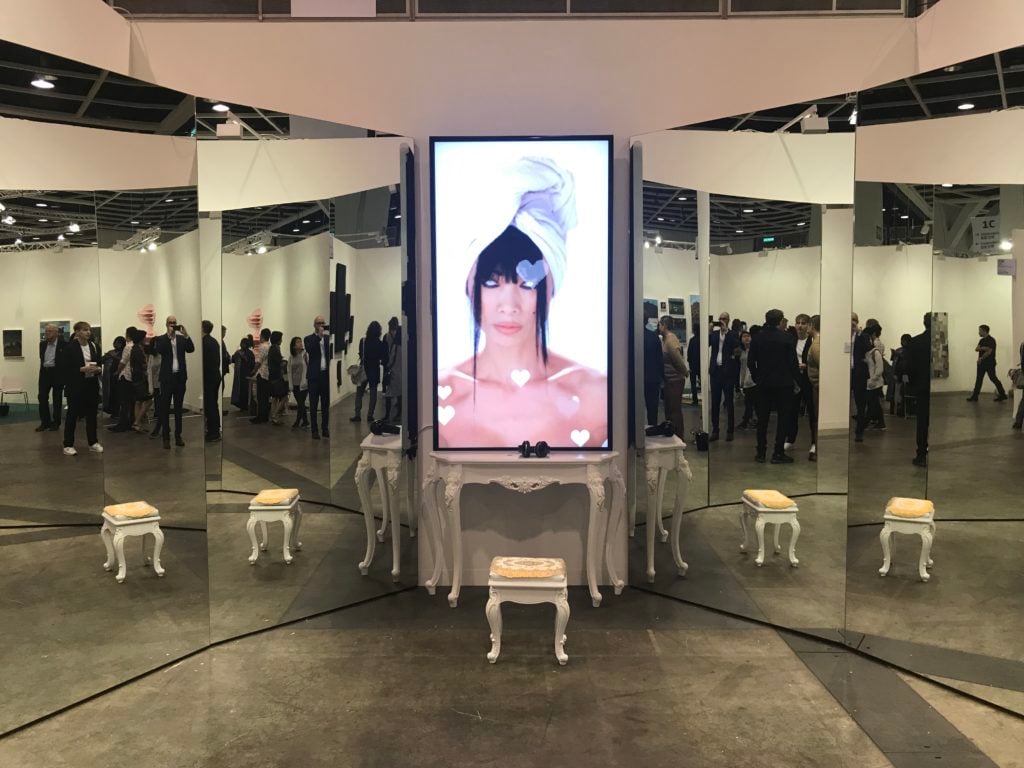
Photo by Andrew Goldstein.
A young Qatari artist based in London, Sophia Al-Maria has long been a fan of the flamboyant Chinese actress Bai Ling’s blog, which the provocative star—who is known for taking a minimalistic approach to clothing in her public appearances—fills with touching affirmation slogans, so when the two were on a film jury together they quickly struck up a friendship. That meeting of the minds has now yielded a memorable installation at the fair, where a video of the actress growling her Twitter slogans as little emoji hearts stream over her face plays atop a vanity in a selfie-optimized mirrored suite. The first Chinese woman to appear on the cover of Playboy, Bai has suffered for her personal style, enduring misogyny in Hollywood and a mixture of fame and opprobrium in her native China—factors that drew the interest of Al-Maria, who is more often known for her work dealing with Gulf Futurism, a term she coined.
Andy Warhol
Mao (1973)
Pace Gallery – worldwide
$5.5 million
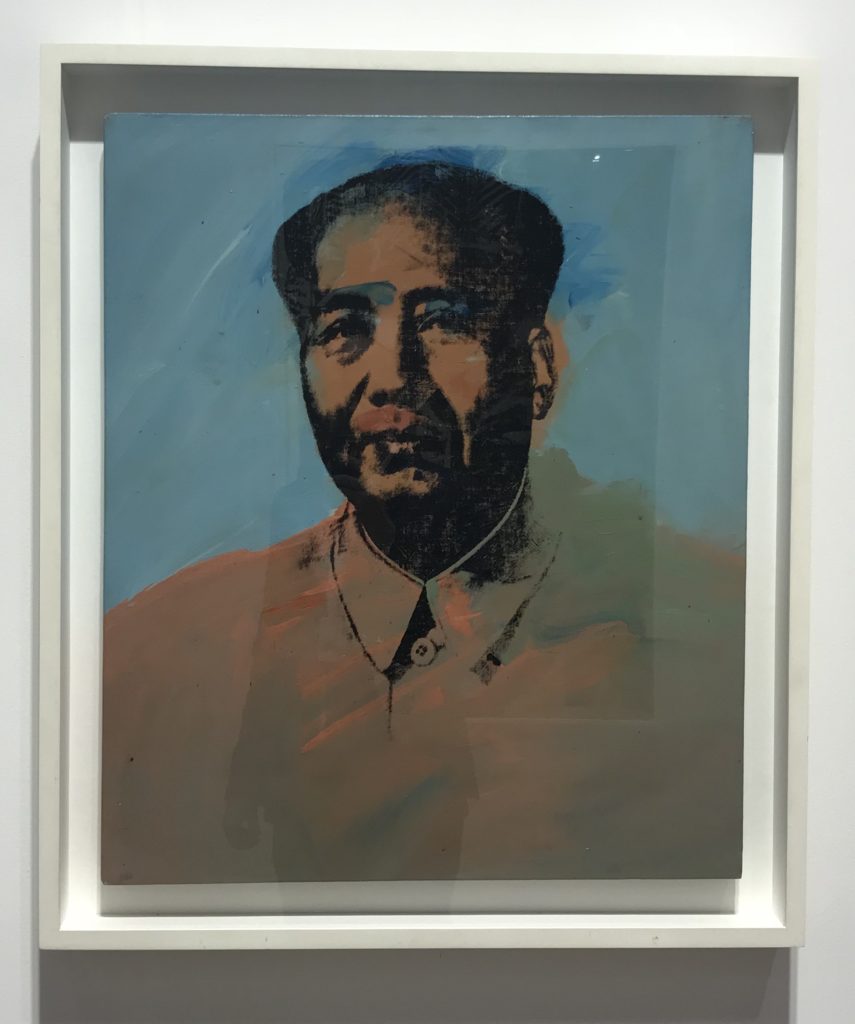
Photo by Andrew Goldstein.
Marc Glimcher and his father Arne opened Pace Gallery’s first outpost in Beijing 10 years ago, in 2008, and the gallery’s thronged booth at the fair indicated that those years of engaging with China’s art community have paid off. Initially it was a slow process of cultivation and education, primarily selling famous Chinese artists to Chinese collectors, but the introduction of Western art into this marketplace is now complete—“three years is all it took for Western art to be fully integrated into Asian collecting,” Marc Glimcher marveled. This Warhol Mao seems to be a poster-worthy celebration of the current market moment. An unusually beautiful piece by the Pop artist, who tended to make it tough, its colors evoke Willem de Kooning’s Springs paintings, and it recalls the moment in time when the two cultures were first coming together in the modern era.
“This painting reminds us that this confluence has been going on for a long time,” Glimcher said. “Westerners don’t appreciate how influential the ideas of Asia have been on us all growing up. We at the gallery have been pretty influenced by this place. We’ve been influenced to think about how you have to build the connections when you go to places that don’t yet have a systematic connection to the art world. It’s not so different from going to Palo Alto these days.” For galleries that have the luxury to commit to 10-year plans, Pace’s strategy is a good one to follow.
